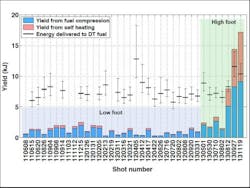
Publications from the Wall Street Journal to the Huffington Post hailed the new results from the National Ignition Facility in the February 20, 2014 issue of Nature as a "fusion breakthrough." The progress of the "high foot" experiments at the Lawrence Livermore National Laboratory (Livermore, CA) is welcome good news for inertial confinement fusion. But should it count as a "breakthrough" in the big picture of fusion research?
The "high foot" tests performed last fall illuminate the fusion hohlraum with extra laser power early in the laser pulse in an effort to improve the early stages of fuel compression. An August 2, 2013 test tripled the yield of fusion energy to about 8 kJ, and a test at the end of September did even better.
The Nature paper details results of those two tests and a third in November. As shown in the figure, the September 27 test reached a yield of 14 kJ and the November 19 test yielded 17 kJ. In the August test, the fusion energy yield fell just short of the x-ray energy from the hohlraum coupled to the deuterium-tritium fuel pellet. However, both the September and November tests yielded fusion energy that exceeded the x-ray energy delivered to the target. That's the first report of what a team led by Omar Hurricane calls "fuel gain exceeding unity."That's a definite sign of progress. So is the increasing fraction of the fusion energy that comes from self-heating rather than from fuel compression, which dominates at lower yields. But NIF was built to demonstrate ignition of a fusion reaction, defined as generating more fusion energy than the 1.8 MJ delivered to the fusion target (i.e., the hohlraum containing the D-T pellet). The new results improved fusion yield by an order of magnitude over earlier D-T experiments, but two orders of magnitude remain to match the 1.8 MJ in the input laser pulse.
The "high foot" tests crucially showed that pulse shaping can reduce instability of the fuel implosion, which has been a crucial problem. But the "high foot" pulses do not scale simply to drive fuel implosions to ignition. "Hohlraum physics is limiting our ability to use the full power capability" of NIF, the authors write in Nature, so they are exploring new strategies. Taming those problems to see a clear path to ignition would be a breakthrough.
Even if NIF itself cannot reach ignition, it provides the experimental facilities we need to learn how to control fusion implosions. The real problem is the scale of the experiments needed to understand the inertial confinement fusion process well enough to control it. NIF cost $3.5 billion and took 15 years to complete, and we likely will need another even more costly testbed to validate what we learn from it. Finding that money will be a challenge.
About the Author
Jeff Hecht
Contributing Editor
Jeff Hecht is a regular contributing editor to Laser Focus World and has been covering the laser industry for 35 years. A prolific book author, Jeff's published works include “Understanding Fiber Optics,” “Understanding Lasers,” “The Laser Guidebook,” and “Beam Weapons: The Next Arms Race.” He also has written books on the histories of lasers and fiber optics, including “City of Light: The Story of Fiber Optics,” and “Beam: The Race to Make the Laser.” Find out more at jeffhecht.com.

